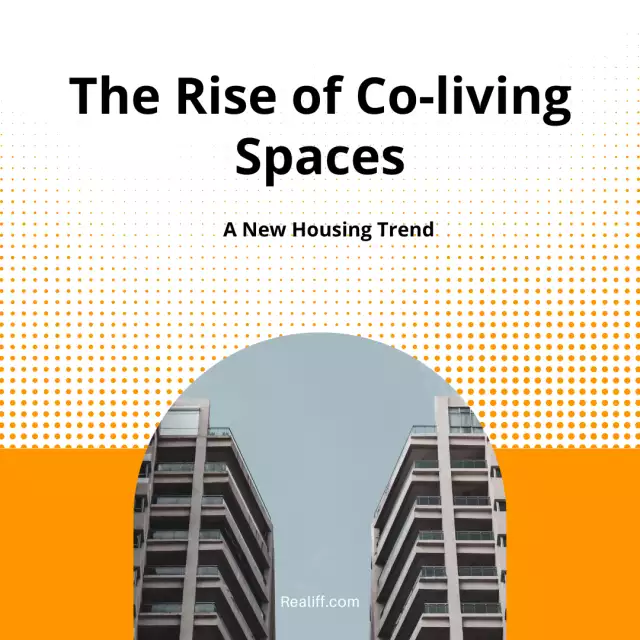The Rise of Co-living Spaces: A New Housing Trend
In recent years, a new housing trend has been taking the real estate marketby storm: co-living spaces. Gone are the days when traditional housing options were limited to renting an apartment or buying a house. Co-living offers a fresh approach to communal living, providing individuals with a unique and affordable housing solution that fosters a sense of community and shared experiences. In this blog post, we will explore the rise of co-living spaces and delve into the reasons behind their growing popularity.
Defining Co-living Spaces:Co-living spaces, also known as co-housing or shared living, are residential properties that offer private living spaces alongside shared common areas. These spaces are designed to cater to the needs of young professionals, digital nomads, and individuals seeking a more affordable and sociable way of living. Co-living spaces typically consist of fully furnished apartments or rooms, with shared kitchens, living rooms, and recreational areas.
Affordable and Flexible Living:One of the primary factors contributing to the rise of co-living spaces is affordability. In many urban areas where housing prices are skyrocketing, co-living provides a cost-effective alternative. By sharing living expenses, such as rent, utilities, and maintenance costs, residents can enjoy lower monthly bills. Additionally, co-living spaces often offer flexible lease terms, allowing tenants to rent on a month-to-month basis, providing the freedom to move in and out without the burden of long-term commitments.
Fostering a Sense of Community:In an increasingly digital and disconnected world, co-living spaces aim to bring people together and foster a sense of community. These spaces are designed to encourage interaction among residents through shared amenitiesand communal activities. From organized events and workshops to co-working spaces and shared dining areas, co-living spaces create opportunities for individuals to connect, collaborate, and build lasting relationships.
Convenience and Amenities:Co-living spaces often come with a range of amenities that make everyday living more convenient. Many facilities provide cleaning services, maintenance, high-speed internet, and even utilities included in the rent. Some co-living spaces also offer additional perks such as gyms, swimming pools, rooftop gardens, and social areas, enhancing the overall living experience and promoting a healthy work-life balance.
Embracing Diversity and Collaboration:Co-living spaces are known for attracting a diverse group of individuals from various backgrounds, cultures, and professions. This diversity creates a rich and vibrant living environment where people can learn from one another, share experiences, and collaborate on projects. The exchange of ideas and perspectives within co-living spaces often leads to personal growth, increased creativity, and the development of new professional opportunities.
Is it possible to get a mortgage on a home built of concrete?
Professional Networking Opportunities:Beyond the social aspect, co-living spaces offer unique networking opportunities. Living with like-minded individuals often means being surrounded by professionals from various fields. The shared spaces and events facilitate networking, enabling residents to expand their professional circles and potentially forge valuable business connections. Co-living spaces can act as a breeding ground for collaborations, startups, and entrepreneurial ventures.
(FAQs) about co-living spaces:
What is the difference between co-living and a traditional apartment or shared house?
Co-living spaces differ from traditional apartments or shared houses in that they emphasize community and shared experiences. While traditional setups may focus primarily on individual living spaces, co-living spaces provide a balance between private rooms and shared common areas, fostering a sense of togetherness and creating opportunities for social interactions.
Are co-living spaces only for young professionals?
No, co-living spaces are not limited to young professionals. While they do attract many young individuals looking for affordable housing and a vibrant community, co-living spaces welcome people of different ages, backgrounds, and professions. The diversity within co-living spaces often enriches the overall living experience and promotes a culture of inclusivity.
How are expenses shared in co-living spaces?
In co-living spaces, expenses such as rent, utilities, and maintenance costs are typically divided among the residents. Each tenant contributes a predetermined amount, either equally or based on factors like room size or amenities used. Shared expenses are usually managed through a central system or by a designated co-living space management team.
What amenities and services are typically offered in co-living spaces?
Co-living spaces often provide a range of amenities to enhance the living experience. Common amenities include fully furnished rooms, shared kitchens, living rooms, laundry facilities, high-speed internet, and utilities. Additionally, many co-living spaces offer extras like cleaning services, gyms, coworking spaces, recreational areas, and organized social events.
Can I choose my roommates in a co-living space?
In some co-living spaces, you may have the option to choose your roommates if you are joining as a group or have specific preferences. However, if you're joining individually, the management team of the co-living space typically matches roommates based on compatibility factors such as lifestyle preferences, interests, and values, to ensure a harmonious living environment.
How long can I stay in a co-living space?
The duration of stay in a co-living space can vary. While some co-living spaces offer short-term options for a few weeks or months, others provide longer-term leases. Many co-living spaces offer flexible lease terms, allowing residents to rent on a month-to-month basis, providing the freedom to move in and out without long-term commitments.
What You Should Know Before Buying a Home about an HOA Foreclosure
Are co-living spaces available in all locations?
Co-living spaces have gained popularity in urban areas, where housing costs are often higher. However, their availability may vary depending on the location. Major cities and metropolitan areas tend to have a greater selection of co-living spaces, but they are gradually expanding to other regions as the trend grows.
How do I find and choose the right co-living space for me?
To find a suitable co-living space, you can start by researching online platforms and websites that specialize in co-living listings. These platforms often provide detailed information about the available spaces, amenities, pricing, and location. Additionally, reading reviews and testimonials from current or previous residents can offer valuable insights into the experiences within different co-living communities. Remember to consider factors such as location, pricing, amenities, community values, and compatibility with your lifestyle preferences when choosing a co-living space that aligns with your needs and expectations.
Conclusion
Co-living spaces present a unique and exciting housing trend that offers a refreshing alternative to traditional living arrangements. By addressing the need for affordability, fostering a sense of community, and providing convenient amenities, co-living spaces are transforming the way people live and interact. With the inclusion of these FAQs, we hope to provide a comprehensive overview to help individuals better understand the concept of co-living spaces and make informed decisions when considering this housing trend. As the popularity of co-living spaces continues to grow, it's important to explore the specific features, benefits, and considerations that each co-living community offers. Conducting thorough research, visiting potential spaces, and engaging with current residents or management teams can provide valuable insights into the dynamics and suitability of a particular co-living space. When evaluating co-living options, it's crucial to consider your personal preferences and requirements. Reflect on factors such as the desired location, budget, lease terms, community values, and the type of amenities and services that are important to you. By aligning these factors with your individual needs, you can find a co-living space that offers a fulfilling living experience.
In conclusion, the rise of co-living spaces represents a paradigm shift in the way we approach housing. With affordability, community, convenience, and networking opportunities at the forefront, co-living spaces have captured the attention of individuals seeking a more connected and dynamic living environment. By embracing this new housing trend, you have the opportunity to experience a vibrant community, forge meaningful relationships, and enjoy a unique and fulfilling way of life. So, why not explore the world of co-living and embark on a new housing adventure?







